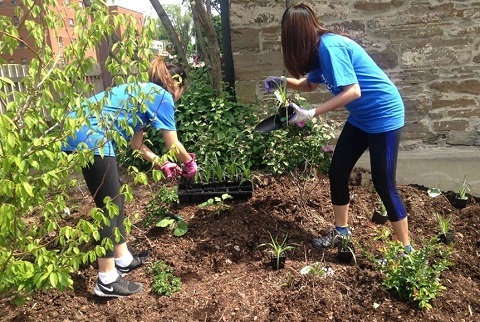Seven tips to help pollinators

Make sure the plants you purchase are pesticide-free. (Credit: Koris Moir)
Native bees and honeybees are still facing decline.
You've already done so much -- made a bee bath, started a mason bee house, built a bumblebee house, even kept a messy yard! I quizzed Shelly Candel, director of Bee City Canada, about her top tips to help pollinators.
Tip 1: Choose native plants. Pollinators are best adapted to local, native plants, shrubs and trees. (I suggest joining a native plant society to find the best local plant lists.)
Tip 2: Get rid of your lawn. It's a desert for pollinators (and most wildlife). Transform it into a pollinator paradise! (I suggest getting your lawn off grass, growing sunflowers, and keeping a mud puddle.)
Tip 3: Bee bountiful. Plant big patches of each native plant species for more efficient foraging (it's less distance for bees to travel). This can also boost curb appeal with big patches of colour to attract both pollinators and humans.
Tip 4: Untidy yards help. Most bees are solitary and nest in the ground. Leave some areas of your property dry, uncultivated and unmulched. Brush piles and dead or dying trees also make great homes for pollinators. Some pollinators also need muddy patches and stones to perch. All bees need a source of water, with a perch. (I say make a bee bath!)
Tip 5: Bee showy. Flowers should bloom in your garden over the seasons, from early spring to late fall. Choose a diversity of native plants and flowers of all shapes and sizes to match pollinator diversity.
Tip 6: Bee chemical-free. Herbicides and pesticides harm bees and other pollinators. Make sure the flowers you purchase are pesticide-free. One study found "23 percent of bee-friendly garden plants sold at top retailers in 14 cities have been treated with neonicotinoid pesticides, the class of pesticides implicated in bee die-offs."
Tip 7: Buy pollinator-friendly food. Support local farmers and beekeepers who do not use neonics.
What else would surprise people about bees?
There are 20,000 known bee species worldwide and more than 800 native bee species in Canada. Each is unique and pollinates different plants at different times. For example, squash bees are the best for squash, pumpkins and gourds!
There are over 140,000 different species of pollinators in Canada. Even a small pollinator garden will bring in many pollinator species, especially native bees. Enjoy your garden and have fun watching these amazing insects at work. My favourite is the green metallic sweat bee, one of the smallest bees and a fast flyer.
What else would you like to know about supporting native bees in your yard or garden?
Sincerely,
Lindsay Coulter, a fellow Queen of Green
Hey! Want more DSF? Join David Suzuki on Facebook

David Suzuki's Blog
- David Suzuki's profile
- 247 followers



